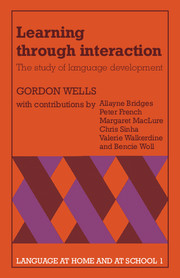Book contents
- Frontmatter
- Contents
- Acknowledgments
- Introduction
- 1 Language as interaction
- 2 Becoming a communicator
- 3 The development of comprehension
- 4 Context, meaning and strategy in parent–child conversation
- 5 Developing linguistic strategies in young school children
- 6 A comparison of talk at home and at school
- 7 Language, literacy and education
- Appendix Bristol language development study: transcripts
- References
- Index
4 - Context, meaning and strategy in parent–child conversation
Published online by Cambridge University Press: 05 June 2012
- Frontmatter
- Contents
- Acknowledgments
- Introduction
- 1 Language as interaction
- 2 Becoming a communicator
- 3 The development of comprehension
- 4 Context, meaning and strategy in parent–child conversation
- 5 Developing linguistic strategies in young school children
- 6 A comparison of talk at home and at school
- 7 Language, literacy and education
- Appendix Bristol language development study: transcripts
- References
- Index
Summary
The previous two chapters have been concerned firstly with the development of language from its earliest beginnings in mother–infant interaction and secondly, and more specifically, with the development of comprehension. In the present chapter we shall be considering the relationship of language to the social context, and the role which context plays in the child's productive mastery of meaning and interactive skills. The view of language which we take here is a constitutive one: not only do participants rely upon context in making sense of one another's utterances but, in quite important ways, that context is brought into being or constituted through the use of language. From this position, social settings and relationships are not seen as independent or external variables which operate upon the child to determine his language development. Rather, they are established and maintained by the concrete interactional behaviours through which the child enacts them in collaboration with those around him. The means by which they are enacted are largely linguistic: it is through the use of language that the child, his parents and his peers constitute and display their social relationships, one with another. In this sense, then, we may look upon social settings and relationships as interactional achievements. As such, their existence is as much dependent upon the participants' use of language as that use of language is dependent upon them.
In the first part of this chapter we shall be expanding and illustrating these ideas by reference to transcribed excerpts of conversations between children and their parents and peers.
- Type
- Chapter
- Information
- Learning through InteractionThe Study of Language Development, pp. 157 - 182Publisher: Cambridge University PressPrint publication year: 1981



